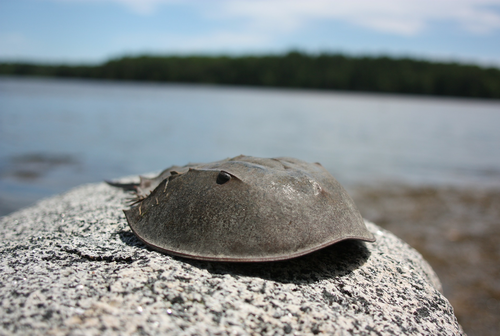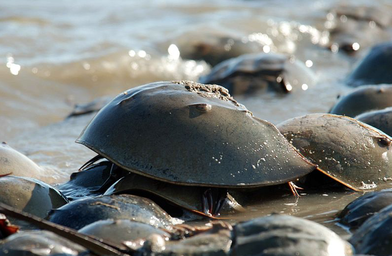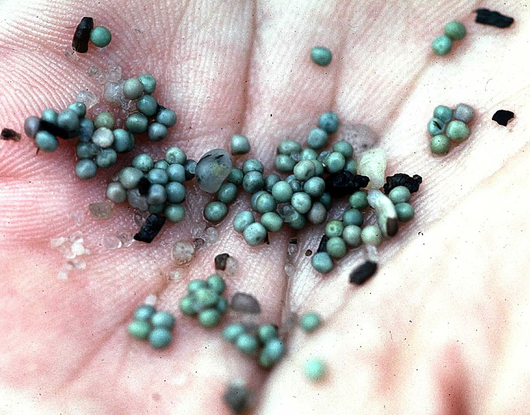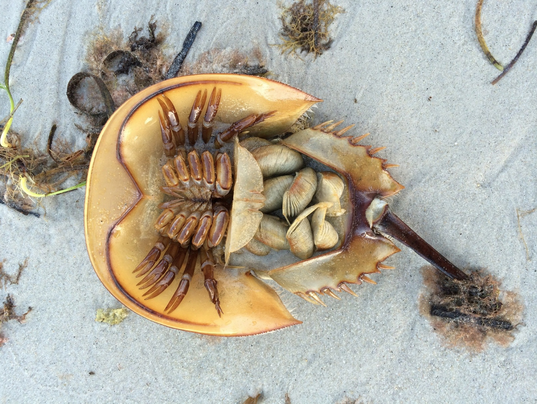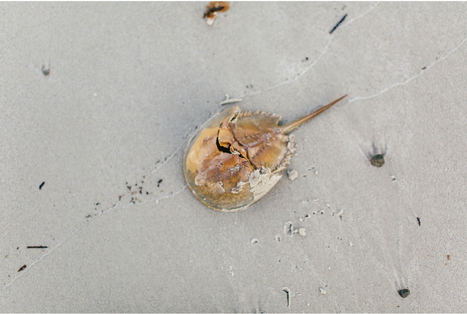 Photo by Michael Browning on Unsplash Photo by Michael Browning on Unsplash Not many species have survived through all the catastrophic Mass Extinctions, but the horseshoe crab did! It has outlived dinosaurs; it has been around for more than 450 Million Years, which is the reason why it is dubbed as The Living Fossil. The horseshoe crab is actually not a crab and also not a crustacean. It is an arthropod that lives in shallow water and muddy pockets. Of its four living species, three are found in Asia and only Limulus polyphemus is found on the Atlantic coast of North America. Why is Limulus Amebocyte Lysate important to humans? The horseshoe crab was used as bait by fishermen and as a fertilizer by farmers. But in recent years, this crab has been found to be the source of an invaluable chemical found in its blood. It is called Limulus Amebocyte Lysate also known as LAL. Limulus comes from the genus name Limulus polyphemus, Amebocyte is cells in the crab’s blood, and the lysate is the extract once Amebocyte has been “degraded.” This particular chemical extracted from the blood is extremely sensitive to endotoxins (infectious chemicals produced by bacteria). Thereby, LAL is used to detect endotoxins in vaccines, injectables, and equipment used in medical procedures that are supposed to be sterile, like artificial knees and hearts. Endotoxin detection plays a key role in maintaining the security of the equipment and chemicals and prevents any complications post-usage. Without this living legend, the biomedical industry would be crippled. These crabs are harmless creatures that every year come to lay eggs all over Asia and the Atlantic. From here, they are picked up by pharmaceutical companies. What is special about horseshoe crab blood? In the 1950s, there was this pathologist Dr. Frederick Bang. Dr. Bang has always been interested in studying the invertebrate circulatory system to better understand vertebrate one. While working at the Marine Biological Laboratory, Maine, Bang studied the response of the open circulatory system of the horseshoe crab to bacterial infections. He was the first to introduce this blood as an alternative to a procedure involving rabbits. Two types of blood cells are found in horseshoe crab’s blood; amebocytes and cyanocytes. The latter contains a copper-containing protein, hemocyanin, and for this reason, the blood of horseshoe crab is blue in color when oxygenated or exposed to air. Amebocytes (granulocytes) are of prime importance in their immune response against endotoxins. The granulocytes contain a special protein, coagulogen (from coagulate), responsible for blood clotting. It is released when they’re exposed to endotoxin. Dr. Bang was fascinated by the immune properties of this blue blood of horseshoe crab. He saw when this blue blood is inoculated with the bacteria or toxin, it started to clot. The clot was so strong that it would hold even when boiled for 5 minutes. This clotting in the arthropod’s body served to block the infected part from infecting the region, which was not. In other words, it immobilized the bacteria. It was all about Gram Negative bacterial endotoxin! The horseshoe crab has open circulation and never developed any immune system, so they rely totally on a sealing-off mechanism to control the spread of toxin or disease. This led to the foundation of the LAL test. Furthermore, one of his crabs died from an unknown infection that had clotted nearly the whole blood volume in the crab. He isolated the bacterial culture and inoculated it into other crabs. They all met the same fate. And these endotoxins were produced by Gram-negative bacteria only! The use of this LAL test proved easy and very accurate. This started a wild hunt for these arthropods, and the price of their blood started to climb. Bang collaborated with a hematologist Jack Levin to better understand the underlying clotting mystery. Bang was having trouble with keeping the cells from clotting during research. None of the anti-coagulant was effective. To test the hypothesis of whether this coagulation was due to bacteria or any of its components, Levin prepared sterile samples in endotoxin-free glassware. Surprisingly, there were no blood clots! That 'eureka' moment was his realization that the phenomenon is triggered by endotoxins produced by Gram-negative bacteria. Levin was able to show that endotoxin-sensitive amebocytes were responsible for the entire mechanism of blood coagulation in Limulus. Ultimately, he patented the standardized LAL test, which would use horseshoe crab for endotoxin testing, and return results early in 45 minutes. This efficiently replaced the costly Rabbit Pyrogen Test; prior to this life-saving chemical, the serums and vaccines were all tested by injecting them into rabbits. Then the temperature of rabbits were measured every 30 minutes. Spike in temperature showed contamination of the inoculated serum by bacteria. LAL test approval led to the horseshoe crab hunt. For its quick and convenient results, the FDA approved LAL test in 1977 to replace rabbit colonies. With the LAL test kit, you just add LAL to the vile, flip it over, and see if it turned gel-like solid clumps. It took almost two decades to get approved by FDA. One reason why it took so long could be the resistance to change! It would need time, money to revamp the production lines. LAL endotoxin screening test is one of the “100 Most Important Contributions to Public Health” by the Johns Hopkins Bloomberg School of Public Health. Dr. Anthony Dellinger from the University of North California, Greensboro, in association with Kepley Biosystems Incorporated, developed an improved aquaculture system to facilitate repetitive LAL collection from well-monitored and well-maintained horseshoe crabs. For this, crabs were captured, and a tube was surgically implanted into them for collection of their blood thrice per month, a volume that suffices market needs. The blood is then centrifuged to obtain amebocytes concentrate. The addition of water causes Amebocyte to lyses and releases the coagulant proteins, which react with the endotoxins (lysate). Using this approach, 600,000 Horseshoe crabs were captured annually. They are bled dry before returning to oceans, where most of them don’t really survive. An estimated 50,000 horseshoe crabs die each year during the process. Recombinant Factor C; A Sustainable Approach to Horseshoe Crab Blood Another pathologist in the late 70s was looking for a solution to this problem. Pathologist Jeak Ling Ding with her research partner, also her husband, Bow Ho, waded into the mud in search of horseshoe crabs. She wanted to use the modern technology that was now available due to vast progress in the world of biotechnology. They wanted to open up the genome of the horseshoe crab and find out what made that blood toxin-sensitive. It turns out that there was a factor C that made it all possible. Now, all there was left was to somehow place that gene responsible for factor C into yeast and start producing the copies of that gene. This would enable the world to still have the chemical they need, and there would be no more killing of the animal. It was difficult to cultivate the gene outside the organism. First, the blood’s sensitivity to bacterial toxins made it difficult to study, and all the glassware had some sort of toxins on them, so they had to get special equipment for the study. They tried growing colonies of crabs in the lab and, well, that failed. Normal yeast would not secrete the molecule even if it produced factor C. So, she inserted the isolated gene into an insect’s gut cells using a baculovirus virus system to make the chemical. The modified insect turned into little factories that produced recombinant factor C (rFC). This delay caused the rFC kit to come out as late as 2003. And the response from the pharmaceutical industry was not very warm. Most of them just did not trust the sensitivity of the artificial kit because, according to them, it had not been tested sufficiently. “As a researcher, we’re delighted to see it is working. We hoped that world would shift to recombinant factor C and save the horseshoes crabs of the gruesome process,” she says. The second problem was that this kit was available from only one company that’s part of a Switzerland-based company, Lonza. Pharmaceutical companies were worried that what they would do if Lonza went out of business and one company will control the market, which would be a disadvantage to the companies buying. FDA approvals came a decade later, and this also helped maintain the reluctance among the pharmaceutical industries. However, Lonza is not the sole distributor of LAL kits. Hyglos joined the revolution in 2013. In 2016, European Pharmacopoeia added factor C as a bacterial-toxin test. But as the number of these crab dwindle, the world has started to care. To maintain the ecosystem, many places have banned their hunting and bleeding. The dwindling number has caused the companies to shift to the recombinant kit. More and more companies are applying for the FDA approval of the kit, and it is no longer the possession of Lonza or Hyglos only. Why should we care about horseshoe crabs? The horseshoe crabs were important for human survival. Even with the invention of sustainable rFC kits, they aren’t celebrated much in the biomedical industry. However, the hunting and bleeding of these arthropods have caused severe problems for this species and others dependent on it. The living fossil was put on the IUCN vulnerable species list in 2016. During their journey from South America, migratory shorebirds, particularly red knots, rely on the horseshoe crab eggs for nourishment. Even the young horseshoe crabs are gobbled up by some fish like striped bass, striped killifish, flounder, Atlantic silversides, and loggerhead sea turtles. Of all these species, the red knot and the loggerhead sea turtle suffered greatly with the declining horseshoe crab population. Also, they were normally used by humans as bait for eel and whelk. By the time regulations were introduced, significant damage had been done to both horseshoe crab and eel populations. The extensive blood harvesting also depleted the waters of this crab. This means they’ve important links in aquatic food webs. There is an urgent need for the conservation of horseshoe crabs. You can opt for conservation programs like ReTURN the Favor by Ecological Research and Development Group (ERDG), where volunteers flip over the helpless crabs turned upside down even by gentle waves (they can’t right themselves up). With our knowledge far from complete about the ecological role of such a living fossil, it’d be hard to find all of them a better substitute! AuthorNida Riaz is a freelance blogger based in Pakistan. She started writing about her passion for the environment when the world came to a stop in early 2020.
0 Comments
Leave a Reply. |
|
|
(833) CMS-LINE
(833) 267-5463 PO Box 13477 Mill Creek, Wa, 98082 © Conservation Made Simple. All rights reserved.
501(c)(3) Non-Profit, Tax ID#: 82-1646340 Copyright © 2021 Conservation Made Simple |

